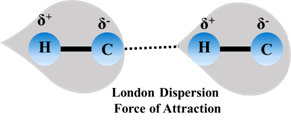
Concept explainers
Interpretation:The intermolecular forces present in the spilled oil from a pipeline and the pipeline oil have to explain.
Concept Introduction:In molecules having no permanent dipole like hydrocarbons the electronic atmosphere is supposed to be symmetrical. But this is true only on a time average. Rapid and continuous changes in the intensities of charge concentration in the electron atmosphere may give rise to instantaneous and fluctuating dipoles as shown in the figure. These dipoles may induce further dipoles on adjacent molecules. The resulting weak short range forces are called London Dispersion Forces. The forces increase with increasing polarisibility and hence molar volume among comparable species. Usually these are related to molecular weight but the polarisibility is always important in this force of attraction.
 |
Want to see the full answer?
Check out a sample textbook solution
Chapter 8 Solutions
Chemistry for Engineering Students
- why are some gases polar molecules? For example, SO2 is a polar molecule and a gas. CHCl3 is a polar molecule but a liquid. How come these two examples are both polar molecules but are in different states of matter?arrow_forwardKBr has a lattice energy -671 kJ/mol. Consider a hypothetical salt XY. X3+ has the same radius of K+ and Y3− has the same radius as Br−. Estimate the lattice energy of XYXY.arrow_forwardPropylene, C3H6, is a gas that is used to form the importantpolymer called polypropylene. Its Lewis structure is (a) What is the total number of valence electrons in the propylenemolecule? (b) How many valence electrons are usedto make s bonds in the molecule? (c) How many valenceelectrons are used to make p bonds in the molecule? (d) Howmany valence electrons remain in nonbonding pairs in themolecule? (e) What is the hybridization at each carbon atomin the molecule?arrow_forward
- There are many tips out there for cleaning, cooking, etc., which take advantage of the polarity and physical properties of substances to make our lives more efficient. What are the example of intermolecular forces of attraction that can be seen in our lives through cleaning, cooking, etc.?arrow_forwardCH3COCH3 (acetone) is a common laboratory solvent that is often used in nail polish remover. Its Lewis structure and space-filling molecular image are shown here: Acetone is a polar molecule; the oxygen end has a slightly negative charge (oxygen is more electronegative), whereas the carbon and hydrogen end has a slightly positive charge. In liquid acetone, the molecules are attracted to each other via these polar ends-the positive end of one molecule is attracted to the negative end of its neighbor-and therefore align as shown here: Draw a Lewis structure and space-filling molecular image for CH2Cl2 (dichloromethane), another common laboratory solvent. Is the molecule polar? Which end of the molecule has a slightly negative charge? Which end has a slightly positive charge? Draw several space-filling molecular images of CH2Cl2 showing how they align in liquid dichloromethane.arrow_forward7.52 How does orbital overlap explain the buildup of electron density between nuclei in a chemical bond?arrow_forward
- Halothane, which had been used as an anesthetic, has the molecular formula CHBrClCF3. Write the Lewis structure for halothane. Is halothane a polar molecule? Explain your answer. Can hydrogen bonding occur in halothane? Explain.arrow_forwardExplain why bonds occur at specific average bond distances instead of the atoms approaching each other infinitely close.arrow_forwardBond Enthalpy When atoms of the hypothetical element X are placed together, they rapidly undergo reaction to form the X2 molecule: X(g)+X(g)X2(g) a Would you predict that this reaction is exothermic or endothermic? Explain. b Is the bond enthalpy of X2 a positive or a negative quantity? Why? c Suppose H for the reaction is 500 kJ/mol. Estimate the bond enthalpy of the X2 molecule. d Another hypothetical molecular compound, Y2(g), has a bond enthalpy of 750 kJ/mol, and the molecular compound XY(g) has a bond enthalpy of 1500 kJ/mol. Using bond enthalpy information, calculate H for the following reaction. X2(g)+Y2(g)2XY(g) e Given the following information, as well as the information previously presented, predict whether or not the hypothetical ionic compound AX is likely to form. In this compound, A forms the A+ cation, and X forms the X anion. Be sure to justify your answer. Reaction: A(g)+12X2(g)AX(s)The first ionization energy of A(g) is 400 kJ/mol. The electron affinity of X(g) is 525 kJ/mol. The lattice energy of AX(s) is 100 kJ/mol. f If you predicted that no ionic compound would form from the reaction in Part e, what minimum amount of AX(s) lattice energy might lead to compound formation?arrow_forward
- hat is the enthalpy change for a process? Is enthalpy a state function? In what experimental apparatus are enthalpy changes measured?arrow_forwardAcrolein is the starting material for certain plastics. (a) Which bonds in the molecule are polar and which are nonpolar? (b) Which is the most polar bond in the molecule? Which atom is the partial negative end of this bond?arrow_forward7.91 A Lewis structure for the oxalate ion is shown below. (One or more other resonance forms are also possible.) What is the correct charge on the oxalate ion? What type of orbital hybridization is expected for each of the carbon atoms in this structure? How many sigma bonds and how many pi bonds does the structure contain?arrow_forward

 Chemistry: An Atoms First ApproachChemistryISBN:9781305079243Author:Steven S. Zumdahl, Susan A. ZumdahlPublisher:Cengage Learning
Chemistry: An Atoms First ApproachChemistryISBN:9781305079243Author:Steven S. Zumdahl, Susan A. ZumdahlPublisher:Cengage Learning
 ChemistryChemistryISBN:9781305957404Author:Steven S. Zumdahl, Susan A. Zumdahl, Donald J. DeCostePublisher:Cengage Learning
ChemistryChemistryISBN:9781305957404Author:Steven S. Zumdahl, Susan A. Zumdahl, Donald J. DeCostePublisher:Cengage Learning Chemistry: The Molecular ScienceChemistryISBN:9781285199047Author:John W. Moore, Conrad L. StanitskiPublisher:Cengage Learning
Chemistry: The Molecular ScienceChemistryISBN:9781285199047Author:John W. Moore, Conrad L. StanitskiPublisher:Cengage Learning Chemistry for Engineering StudentsChemistryISBN:9781337398909Author:Lawrence S. Brown, Tom HolmePublisher:Cengage Learning
Chemistry for Engineering StudentsChemistryISBN:9781337398909Author:Lawrence S. Brown, Tom HolmePublisher:Cengage Learning





